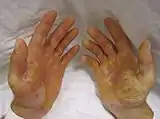Epidermolysis bullosa simplex
| Epidermolysis bullosa simplex | |
|---|---|
 | |
| Epidermolysis bullosa simplex | |
Epidermolysis bullosa simplex (EBS), is a disorder resulting from mutations in the genes encoding keratin 5 or keratin 14.[1]: 598 [2]
Blister formation of EBS occurs at the dermoepidermal junction. Sometimes EBS is called epidermolytic.
Symptoms and signs

Epidermolysis bullosa simplex-(a & b) Absent nails and plantar hyperkeratosis present (c & d) herpetiform skin blistering (e & f) cutaneous lesions
The clinical presentation of this condition is consistent with:[3]
- Aplasia/Hypoplasia of the nails
- Faltering weight in infancy
- Skin ulcer
- Pyloric stenosis
- Neoplasm
- Oral mucosal (blister)
- Palmoplantar blistering
Cause
Absence of keratin-5,14 since birth.
Diagnosis
Classification
Epidermolysis bullosa simplex may be divided into multiple types:
| Type | Locus & Gene | OMIM |
|---|---|---|
| Epidermolysis bullosa simplex with migratory circinate erythema | 12q13 (KRT5) | 609352 |
| Epidermolysis bullosa simplex with mottled pigmentation. | 12q13 (KRT5) | 131960 |
| Epidermolysis bullosa simplex, autosomal recessive | 17q12-q21 (KRT14) | 601001 |
| Generalized epidermolysis bullosa simplex | 17q12-q21 (KRT5), 12q13 (KRT14) | 131900 |
| Localized epidermolysis bullosa simplex | 17q12-q21 (KRT5), 17q11-qter, 12q13 (KRT14) | 131800 |
| Epidermolysis bullosa herpetiformis | 17q12-q21 (KRT5), 12q13 (KRT14) | 131760 |
Epidermolysis bullosa simplex with muscular dystrophy
|
8q24 (PLEC1) | 226670 |
| Epidermolysis bullosa simplex with pyloric atresia | 8q24 (PLEC1) | 612138 |
| Epidermolysis bullosa simplex of Ogna | 8q24 (PLEC1) | 131950 |
Management
- No cure for EB
- Treat symptoms
- Protect skin, stop blister formation, promote healing
- Prevent complications
- Necessary treatment: use oral and topical steroid for healing and prevent complication
- Maintain cool environment, avoid overheating and decreases friction
See also
References
- 1 2 3 4 5 6 Freedberg, et al. (2003). Fitzpatrick's Dermatology in General Medicine. (6th ed.). McGraw-Hill. ISBN 0-07-138076-0.
- ↑ Bardhan, Ajoy; Bruckner-Tuderman, Leena; Chapple, Iain L. C.; Fine, Jo-David; Harper, Natasha; Has, Cristina; Magin, Thomas M.; Marinkovich, M. Peter; Marshall, John F.; McGrath, John A.; Mellerio, Jemima E. (2020-09-24). "Epidermolysis bullosa". Nature Reviews Disease Primers. 6 (1): 78. doi:10.1038/s41572-020-0210-0. ISSN 2056-676X. PMID 32973163. S2CID 221861310. Archived from the original on 2020-11-18. Retrieved 2020-12-05.
- ↑ "Epidermolysis bullosa simplex | Genetic and Rare Diseases Information Center (GARD) – an NCATS Program". rarediseases.info.nih.gov. Archived from the original on 24 May 2021. Retrieved 3 August 2021.
- 1 2 3 4 5 6 James, William; Berger, Timothy; Elston, Dirk (2005). Andrews' Diseases of the Skin: Clinical Dermatology. (10th ed.). Saunders. ISBN 0-7216-2921-0.
- ↑ Harel, A, et al. "Epidermolysis Bullosa Simplex with Mottled Pigmentation Resulting from a Recurrent Mutation in KRT14." Journal of Investigative Dermatology. (2006) 126, 1654–1657. doi:10.1038/sj.jid.5700296; published online 6 April 2006. Archived 2013-10-12 at the Wayback Machine
- 1 2 3 4 Rapini, Ronald P.; Bolognia, Jean L.; Jorizzo, Joseph L. (2007). Dermatology: 2-Volume Set. St. Louis: Mosby. ISBN 978-1-4160-2999-1.
Further reading
- GeneReviews/NCBI/UW/NIH entry on Epidermolysis Bullosa Simplex Archived 2020-10-22 at the Wayback Machine
External links
| Classification | |
|---|---|
| External resources |
This article is issued from Offline. The text is licensed under Creative Commons - Attribution - Sharealike. Additional terms may apply for the media files.